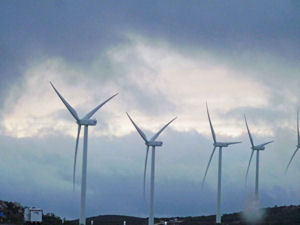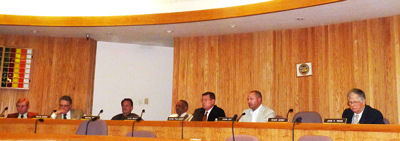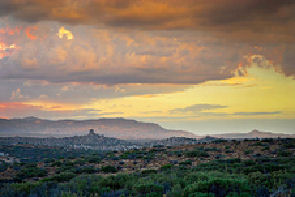 By Miriam Raftery
By Miriam Raftery
April 15, 2012 (San Diego)—The San Diego County Planning Commission voted Friday to postpone action on a proposed wind ordinance after hearing several hours of testimony. The vote was unanimous, with the exception of Commissioner Peder Norby, who abstained due to a conflict of interest.

On one hand, wind industry representatives contended that setbacks and low frequency noise standards proposed would effectively bar most industrial-scale wind projects in our region. On the other hand, rural residents voiced fears that the ordinance did not go far enough to protect health and safety , as well as to preserve many of East County’s most scenic areas that fall within a “wind resources” map. Among the most contentious areas is the “Descanso Wind Resources” area within Cleveland National Forest.
The Board of Supervisors asked staff to develop a two-tiered framework to “simplify” standards and bring wind regulations into line with current wind turbine technologies including newer, larger turbines, a staffer explained. Currently the county has three wind use categories based on heights and other factors. Under the new proposed wind ordinance, there would be two categories. Turbines greater than 50 kilowatts would require major use permits to install, those under 50 KW would not. Smaller turbines would be prohibited on ridges and could have no power lines or lights.
The wind resources in San Diego County are predominantly in East County, including mountain areas such as Julian and the Lagunas, numerous places within Cleveland National Forest, and rural communities such as Boulevard.
 A staff member said low-frequency noise emitted by turbines can cause noise and pressure sensations in neighbors close to turbines due to the”bumping and swooshing” of turbine blades “all day and all night.” He said the sensation has been likened to hearing the bass sound of music. Staff played a Youtube video depicting various sounds made by turbines: http://www.youtube.com/watch?v=E3FvyrHOeB0
A staff member said low-frequency noise emitted by turbines can cause noise and pressure sensations in neighbors close to turbines due to the”bumping and swooshing” of turbine blades “all day and all night.” He said the sensation has been likened to hearing the bass sound of music. Staff played a Youtube video depicting various sounds made by turbines: http://www.youtube.com/watch?v=E3FvyrHOeB0 “Low frequency noise can only be mitigated through distance,” the staffer said. Staff proposed a new low-frequency noise standard based on “C-weighted” dBAs. If standards were found too restrictive, planners would waive the rule on a case by case basis, he added, or a developer could get permission from neighbors.
A State Fish & Game official voiced concerns over impacts on birds and bats particularly if smaller turbines don’t go through review for biological impacts and warned that some small land owners might unknowingly violate state law. The Viejas band of Kumeyaay Indians sent a letter raising concerns over impacts on cultural resources, birds and health—as well as concerns that they were not notified of the hearing.
Donna Tisdale, Chair of the planning group in Boulevard, where multiple industrial wind projects are proposed, presented a slideshow and testified emotionally that wind developers are playing “hardball” with misrepresentations including “actual fraud” to push projects through.
For example, she said some wind industry representatives have claimed turbines are “quiet as a refrigerator” and that golden eagles and other birds can “easily dodge blades moving at 200 mph.”
Industry representatives at the hearing claimed that dirty electricity does not travel through the ground. But Tisdale said in Italy, it has been tested and found to travel over six miles.
It’s happened here, too. Samuel Milham, a retired physician epidemiologist and author of Dirty Electricity, submitted charts showing measurements he’s taken on the Manzanita Indian reservation in East County, near the Kumeyaay wind farm in Campo. His findings revealed extremely high levels of ground voltage in the Manzanita tribal church and tribal headquarters.
“The spectra prove that the Campo wind farm and the utility is the source since the sine waves are at 60 Hz,” he said…At the Tribal Headequarters the ground voltage is 7.3 volts.”
Dr. Milham says infrasound generated by turbines is also an issue, found to cause health problems as far as ¾ mile from blades. “My recommendation is that wind turbines should not be sited within ¾ mile of homes and that it would be prudent to delay wind farm construction until the utilities and the manufacturers can solve their electrical pollution problems,” he wrote in his comments.
Tisdale testified that ground currents and infrasound could affect burrowing animals, birds and other wildlife. She also voiced concerns that turbines would increase fire insurance for area residents.
 She said Interior Secretary Salazar has failed to respond to her request for an investigation into failures at the Kumeyaay wind farm, where all 75 blades had to be replaced after an apparent electrical malfunction in a storm shut down the facility for three months and hurled blade chunks off turbines. She called the matter a “breach of care.” She also quoted a rural resident who said sound from the turbines is “like helicopters hovering overhead.”
She said Interior Secretary Salazar has failed to respond to her request for an investigation into failures at the Kumeyaay wind farm, where all 75 blades had to be replaced after an apparent electrical malfunction in a storm shut down the facility for three months and hurled blade chunks off turbines. She called the matter a “breach of care.” She also quoted a rural resident who said sound from the turbines is “like helicopters hovering overhead.” Slides presented by Tisdale illustrated the massive scale of modern turbines, which can be nearly 500 feet high, taller than the highest skyscraper in downtown San Diego, with blade spans the size of a commercial jetliner’s wingspan.
At an Iberdrola wind facility in Canada, some neighbors had to abandon their farms and homes, Tisdale testified.
Iberdrola proposes to build Tule Wind Farm in McCain Valley on Bureau of Land Management federal recreation lands. The area has already been impacted by Sunrise Powerlink, a factor Tisdale attributes to displacing wildlife. “Three mountain lions were killed on I-8 last month, a record, and CHP just had to chase bighorn sheep off the freeway,” she noted.
Tisdale also pleaded with planners not to gut Boulevard’s community plan in order to facilitate development of industrial-scale wind projects. (Conversely, the commission’s proposal called for changes to preserve views and prevent large-scale turbines in Borrego Springs.) She called for a moratorium on turbines to protect residents and wildlife.

Harley McDonald from Iberdrola testified that the company seeks to “help supply our renewable energy needs” and cited a need for more power in our region with San Onofre now offline, in order to prevent blackouts. She said the proposed ordinance would amount to a “de facto ban” on large-scale wind projects. Iberdrola currently has 12,000 MW of wind installations in 23 countries and claims to be the largest renewable energy supplier in the world.

Another Iberdrola representative , Jeffrey Durocher, objected to the low-frequency sound standard proposed, adding that “Our project in East County has baseline conditions without turbines that exceed the standards.” He added that it’s unrealistic to expect companies to make big financial investments based on the hope of getting a waiver or permission from neighbors.
He likened low frequency noise to “beach waves” adding, “Some people spend a great amount of disposable income to live there.”
A spokesman for Invenergy, another wind company, said concerns over turbines focus on “annoyance” not health and safety. (A planning commission staffer earlier told commissioners that health risks were not considered due to insufficient data, despite existence of peer-reviewed literature documenting clusters of similar symptoms among people living near turbines, such as sleeplessness, headaches, heart palpitations and ringing in the ears.) Invenergy’s spokesman called wind farms a “good fit” with rural lifestyles due to economic development.
Enel, which wants to build a wind facility in Jewel Valley on 3,600 acres owned by the Lansing family, said only 135 of those acres could be utilized for wind under the proposed ordinance, absent a waiver.
Benjamin Weiss, general counsel for Lansing, contended, “If you think you’re going to get Ms. Tisdale to sign a waiver, that’s not going to happen.”
 John Gibson with the East County Renewable Energy Commission launched an even more pointed attack on Tisdale, complaining of a “nuclear warhead from our resident NIMBY.”
John Gibson with the East County Renewable Energy Commission launched an even more pointed attack on Tisdale, complaining of a “nuclear warhead from our resident NIMBY.”Tisdale fired back in her presentation. “I take that as a compliment, but I relate more to backwards NIMBYs, especially when the wind spin doctors are at work.” She displayed a slide showing a bull labeled “Your Bullshit Makes Incredible Nonsense—Be a backwards NIMBY.”
She also showed images of beautiful areas marred or slated to be marred by wind turbines, along with maps showing many new areas in Cleveland National Forest and elsewhere in East County that could become wind facilities in the future. #7

In addition, she said 505 foot setbacks proposed by the County are inadequate—showing images of towering turbines dominating homes even from much further distances. Tisdale says she has spoken with residents in other areas who complain of noise and health problems while living much farther away from turbines than the County proposal would require.
Holly Smithson with CleanTech San Diego argued against the low-frequency noise standard, which she claimed would be the most restrictive wind ordinance in California.
 One slide by a proponent of the ordinance urged the County to “cut green tape.”
One slide by a proponent of the ordinance urged the County to “cut green tape.”But a woman who resides in Borrego Springs testified that living 150 feet from a neighbor’s small turbine, just 160 feet tall, has caused noise and light issues that have ruined her enjoyment of the outdoors at her home. She said other neighbors 500 feet away also have issues and that sounds reach 60 decibels, similar to a “plane of helicopter with blades chopping. It’s not fleeting-it’s continual sounds. What can the County do to restore our right to peace and quiet in the desert?”
A Sierra Club representative called for a key section in the wind resources map to be removed from consideration including a roadless area within a mile of eagle nests near the upper San Diego River Gorge. The spokesperson feared the wind projects could be a “way to dignifiy bringing huge transmission lines across Boulder Creek and across the face of Cuyamaca.”
Laurie Baker, a Santee resident who enjoys hiking in the backcountry, said she supports a “no project” alternative and worries about habitat fragmentation.
ECM editor Miriam Raftery raised concerns over setbacks, health and safety issues, impacts on wildlife and views and urged that the cumulative impact of multiple large projects be considered.
An attorney from Latham and Watkins cited concerns over brownouts with San Onofre offline and urged the commission to move quickly. “Do you want it or do you not?” he said of wind energy. “If we don’t want wind, then let’s move on and do something else.”
Some on the commission seemed inclined to do just that.

Commissioner Bryan Woods said he wants to have a workshop and a fieldtrip to “get educated” more on the issues and voiced concerns over having “wind energy at the expense of folks who have lived there for generations. It’s not right to displace them.” Adding that he’s heard from enough wind industry representatives, he added, “I want to hear from more residents.”
He also suggested that the County should consider imposing stringent sound standards. “I’d even like to make the threshold tougher, to what will be built tomorrow,” he said, indicating he believed the industry would response with turbines that would be quieter and generate less low-frequency sound. “When we decided autos had to get 30-40 mph, it’s amazing how fast that developed,” he remarked. 

Commissioner Michael Beck wanted to know if vertical axis turbines are viable alternatives for small-scale turbines. Proponents have indicated vertical axis turbines are safer for birds, have less visual impact and can produce more megawatts. Beck suggested they might be “silver bullets” adding pointedly, “Until I get clear about that not being a viable alternative, I can’t be serious about this.”
Beck also worried about infrastructure impacts, noting the damage done by Sunrise Powerlink. “Drive out there and you can see it,” he said of the large towers. He wants to see power lines undergrounded, but notes that granite-strewn terrain could be a constraint. He also voiced support for a field trip to see the areas that would be impacted.
Commissioner David Pallinger said there are “many, many issues from many groups” and said consideration of how to resolve issues at the “county and national” levels must be determined.
 Commissioner Leon Brooks said he shared his colleagues concerns and also voiced support for a workshop and field trips.
Commissioner Leon Brooks said he shared his colleagues concerns and also voiced support for a workshop and field trips. Commissioner Riess recalled an incident when a Russian submarine leaked secrets through sounds intercepted and said the Soviets promptly eliminated all leaks. “Can’t we get the C-levels down?” he asked.
The Commission will likely have further discussion on the wind ordinance issues at its next meeting on April 27, with staff provided additional time to address concerns raised. Public testimony will be heard again at a future date not yet determined. Meanwhile a workshop and tour will be organized by staff.
With wind subsidies expiring at year’s end, the wind developers face a steep obstacle to future projects in the U.S.; some have also experienced plummeting stock prices in part due to market uncertainties. Now, those uncertainties also include the future of wind regulations in San Diego.
Commissioner Adam Day suggested moving forward with the general plan changes affecting Boulevard and Borrego, but backed down when staff said that was infeasible given the objections raised. Day then responded, “If we’re going to encourage clean renewable energy, let’s do that…not put up artificial barriers.”
As for what the industry should do in the meantime, Day opined, “Maybe people should just submit their projects and roll the dice.”







Comments
The commissioner's doubts are
The commissioner's doubts are a good sign. Let's hope that common sense continues to prevail and that they remain open to the full truth about “wind farms,” which consists entirely of good reasons to not build them.
Some of these were touched on in an excellent piece William Tucker wrote last month for the American Spectator:
“Prompted by various federal and state government tax incentives plus market-obliterating "renewable mandates," hundreds of square miles of mountain and prairie have been covered with 45-story windmills that look like the archaeological remnants of a previous race of 80-foot giants. These "wind farms" generally produce electricity that is essentially useless. When the wind blows, windmills can force other forms of generation out of the market because they are free of fuel costs. But those other forms of generation have to be kept running just in case the wind dies down. Last year when temperatures rose to 110 degrees in Texas, that state's 7 percent "wind capacity" proved absolutely useless in the heat-induced doldrums.
And wind "farms," it should be noted, always talk in terms of "capacity" rather than output. That's because they only operate about 30 percent of the time. Nobody has yet invented a way to store commercial quantities of electricity and it may be impossible without building facilities of equally gargantuan dimensions -- say an entire city block of rechargeable batteries. Without any means of storage, wind power is essentially a nuisance.
Then there is solar electricity, which, in order to access, California is now planning to cover dozens of square miles of pristine desert (yes, there is already environmental opposition) in order to prove the world can run on sunshine. Solar energy is a bit more concentrated than wind so that it only takes about five square miles of highly polished collectors to produce 100 megawatts -- when the sun shines. In the desert environment, these solar panels will require constant cleaning and polishing to keep them from getting covered with dust and therefore becoming dysfunctional. It's a labor-intensive task that will require lots of water coming from who-knows-where.